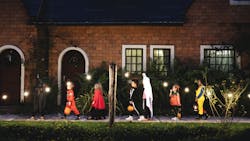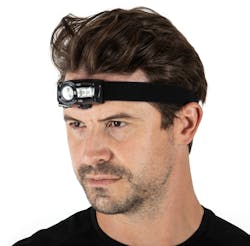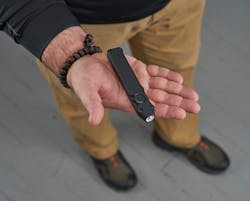Halloween Apparel & Flashlights
Every law enforcement professional who is also a parent has, at some time, gone out Trick-or-Treating with their children. Depending on where in the country you live, that might mean wearing shorts and a T-shirt while your child is in a costume. On the other hand, it might mean wearing long underwear under jeans, a sweatshirt, parka, gloves and boots. No matter how you have to dress to stay warm (or to stay cool), if you are Trick-or-Treating after dark, having a light is mandatory. In fact, you should have a light somewhere on each child, on yourself and then one in your hand for directed light. In this article, we’re going to take a look at some apparel items that make adjusting your comfort level easier and some lights that make being lit/having light be convenient.
Apparel
When it comes to maintaining a core body temperature, whether that means staying cool or staying warm, the answer is layering. To be cooler, you either wear fewer layers or you change to a single layer moisture-wicking anti-microbial material. If the goal is to stay warmer, then having outer garments that can be adjusted accordingly are of value. Once such coat that comes to mind is the 5.11 5-IN-1 Jacket 2.0. Designed with some of the best undercover jacket features integrated (such as hidden patch panels and badge placards) the greatest strength of the 5-in-1 is its modularity.The 5-in-1 is a combination outer-shell jacket and inner-liner jacket. The outer jacket is polyester with mechanical stretch built into the fabric itself. It has five pockets, a microphone loop (if you wanted to wear it on duty), zippered front hand pockets and adjustable cuffs on the sleeves. Both sides of the jacket have 5.11’s “Quixip” system that creates an opening along the bottom hem of the jacket for your holstered weapon to extend through. In other words, it keeps the jacket from covering your gun. Finally, the outer jacket has a removable hood that rolls and stores into the collar when attached.
The inner jacket is polyester tech fleece and zips into the outer shell as well as attaching in at the collar and both sleeve cuffs. This fleece can be worn as a stand alone jacket and the outer shell can be worn without the inner fleece. Combined they provide an insulated, hooded jacket that is water and wind resistant, helping to keep your body heat where it belongs: in your body. The sleeves of the fleece jacket also zip off around the shoulder joint so it can be worn as a vest, or just used as a vest liner for the outer shell.
Beyond using a multi-layered jacket specifically designed for adjustable use as described, you can use the simple combination of T-shirts or base layer shirts, sweatshirts or hoodies and an outer jacket that may or may not be insulated. To maximize the insulation values of your base and middle layers, your outer jacket should be windproof or wind resistant and hopefully will integrate some level of water repellant capability.
Of course, it’s not all about the torso and upper body extremities. If you’re in a region that requires such an insulated jacket, you should also be making sure you have suitable footwear, gloves and a hat. Most boots, whether they are insulated or not, will do a better job of keeping your feet warm and dry than any pair of tennis shoes or loafers you’ve ever seen. Gloves, even non-insulated thin leather or nylon gloves, provide a layer of protection from the wind and minor protection from low temperatures. Most of us heard, when we were children, that 90% of all the heat that left our body went out through the top of our head. While that might not be accurate, some heat does go out that direction, cold can injure your ears and if it’s raining, that cold water will sap body heat four times faster than cold air does. A water-repellant hat, whether insulated or not, especially if it somehow covers the ears, can go a long way to keeping your body heat in and your ears uninjured.
Lights
While this magazine is dedicated to law enforcement and we tend to think about all flashlights as either tactical or not, where Halloween and safety lighting is concerned, there isn’t really a “tactical” light. Yes, some handhelds can be better than others but that’s purely a matter of battery life, weight, size and light production. But carrying a flashlight isn’t the first step toward safe lighting for Halloween. Some type of marker light is necessary. The ASP Sapphire light, a small rechargeable clip-on light, produces 20 lumens and runs for an hour. Clipping one of those on, front and rear, is another convenient way to provide safety lighting.Another option for safety lighting is to get on Amazon and searching for “red runner safety light.” What you’ll get back is a list of options for clip on small lights, many of which have multiple and varying flash patterns. They often run on just one AAA battery and will last for hours longer than you need. Clip one on the front of a child and one on the back—whether it’s high or low on their person—and you have them visible to all pedestrians, bicycle riders and motor vehicle drivers.
Beyond marking the child, front and rear, with some type of safety light, you’ll likely want or need to also carry a flashlight. The “tactical” flashlight is almost always far better than the average home utility flashlight. LED lamps have come a long way as have the digital power distribution circuitry that controls the flow through the lamp. Rechargeable LED lights have also come a long way in the past ten years, so a decent quality one will last you for hours—longer than your typical Trick-or-Treat outing.Another option would be the Streamlight Wedge. Different from other handheld lights, it’s not round, but is rectangular and about the size of your average folding knife. This rechargeable light produces 300 lumens of light but has the capability, with the push of a button, to pump out 1,000 lumens temporarily (however long you hold the button until the battery dies). The run time, on a full charge, at the 300 lumen level, is three hours—more than enough time to make that trip around your neighborhood to fill your child’s candy bucket!
At the end of the night, you want everyone to have stayed warm and not have tripped over anything, fallen into anything or been run over by anyone/anything. It’s easy enough to do with appropriate outer garments and a decent light.

Lt. Frank Borelli (ret), Editorial Director | Editorial Director
Lt. Frank Borelli is the Editorial Director for the Officer Media Group. Frank brings 20+ years of writing and editing experience in addition to 40 years of law enforcement operations, administration and training experience to the team.
Frank has had numerous books published which are available on Amazon.com, BarnesAndNoble.com, and other major retail outlets.
If you have any comments or questions, you can contact him via email at [email protected].







